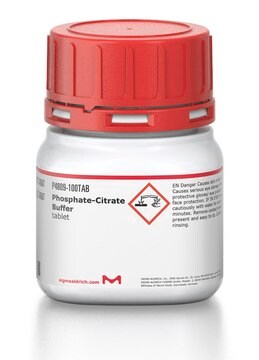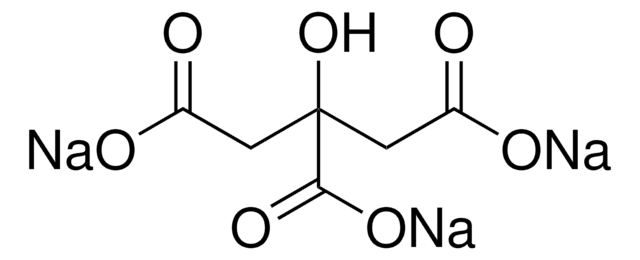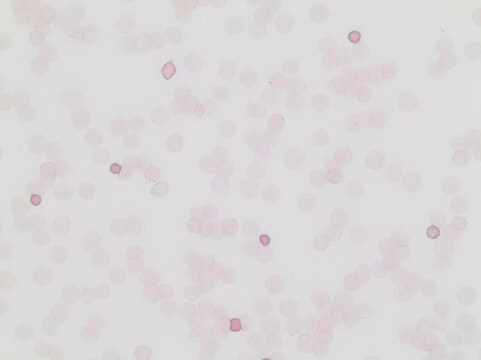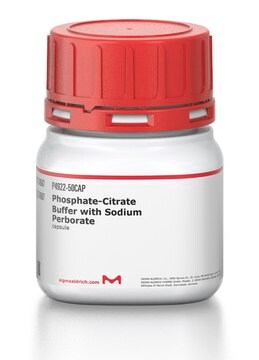C2488
Citrate Buffer Solution, 0.09 M
Sinonimo/i:
Citric Acid Buffer Solution
Autenticatiper visualizzare i prezzi riservati alla tua organizzazione & contrattuali
About This Item
Codice UNSPSC:
12161700
eCl@ss:
32129211
NACRES:
NA.25
Prodotti consigliati
Descrizione
Contains 1% chloroform
pH 4.8 at 25 °C.
Livello qualitativo
Stato
solution
Concentrazione
0.09 M
pH
4.8 (25 °C)
applicazioni
diagnostic assay manufacturing
Temperatura di conservazione
2-8°C
Categorie correlate
Descrizione generale
Citrate Buffer Solution, 0.09 M, is a high-quality biochemical buffer solution commonly employed in various research applications. Its applications include use in acid phosphatase reactions alongside p-nitrophenyl phosphate (pNPP) enzyme substrate. Citrate Buffer is also used for the isolation of RNA from cells and tissues. In addition, it is also used as a background electrolyte for separating sulfonamides utilizing capillary zone electrophoresis. With its superior buffering capacity and ability to maintain a stable pH, Citrate Buffer Solution, 0.09 M is an excellent choice for any researcher in need of reliable performance.
Applicazioni
Citrate Buffer Solution, 0.09 M has been used as a heat-induced antigen retriever on formalin-fixed paraffin-embedded (FFPE) tissue sections during immunohistochemistry (IHC) experiments. It has also been used in the preparation of hybridization solutions for fluorescence in situ hybridization (FISH) procedures.
Altre note
Unit definition: One unit of acid phosphatase will hydrolyze 1.0 μmole of p-nitrophenyl phosphate per, minute at pH 4.8 at 37 °C.
Avvertenze
Warning
Indicazioni di pericolo
Consigli di prudenza
Classi di pericolo
Carc. 2 - STOT RE 2 Oral
Organi bersaglio
Liver,Kidney
Codice della classe di stoccaggio
12 - Non Combustible Liquids
Classe di pericolosità dell'acqua (WGK)
WGK 2
Punto d’infiammabilità (°F)
Not applicable
Punto d’infiammabilità (°C)
Not applicable
Dispositivi di protezione individuale
Eyeshields, Faceshields, Gloves, type ABEK (EN14387) respirator filter
Scegli una delle versioni più recenti:
Possiedi già questo prodotto?
I documenti relativi ai prodotti acquistati recentemente sono disponibili nell’Archivio dei documenti.
I clienti hanno visto anche
I Gkouveris et al.
Histology and histopathology, 32(10), 1065-1076 (2017-01-17)
Signal transducer and activator of transcription 3 (STAT3) and mitogen activated protein kinases (MAPKs), including ERK and JNK, have been implicated in oral squamous cell carcinoma (OSCC) development and progression. Our purpose was to evaluate the levels of activated STAT3
Argyrios G Daskalopoulos et al.
Oral surgery, oral medicine, oral pathology and oral radiology, 129(5), 493-513 (2020-03-17)
Toll-like receptors (TLRs) may promote or inhibit tumor progression. The aim of this study was to assess the expression of TLR4 and TLR9 and their downstream targets in oral tongue squamous cell carcinoma (OTSCC) in correlation with histopathologic parameters and
Nikolaos G Nikitakis et al.
Oral surgery, oral medicine, oral pathology and oral radiology, 125(2), 164-171 (2017-12-19)
Primary oral malignant melanoma (POMM) is a rare type of malignancy with a very poor prognosis, the molecular pathogenesis of which remains elusive. The aim of this study was to assess the expression status of signal transducer and activator of
Greg C Bristow et al.
Cell reports, 31(3), 107536-107536 (2020-04-23)
Chromosome 16p11.2 duplications dramatically increase risk for schizophrenia, but the mechanisms remain largely unknown. Here, we show that mice with an equivalent genetic mutation (16p11.2 duplication mice) exhibit impaired hippocampal-orbitofrontal and hippocampal-amygdala functional connectivity. Expression of schizophrenia-relevant GABAergic cell markers
Zn2+ efflux through lysosomal exocytosis prevents Zn2+-induced toxicity.
Kukic I, Kelleher SL, and Kiselyov K
Journal of Cell Science, 127(Pt 14), 3094-3103 (2014)
Il team dei nostri ricercatori vanta grande esperienza in tutte le aree della ricerca quali Life Science, scienza dei materiali, sintesi chimica, cromatografia, discipline analitiche, ecc..
Contatta l'Assistenza Tecnica.










